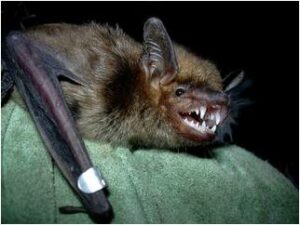Big Brown Bat
Scientific Name: Eptesicus fuscus
Description.
As suggested by its name, the big brown bat is one of the larger species of bats that lives in North Carolina, with weight ranging from 11 to 23 grams and a wingspan of approximately 330 mm. Females are slightly larger than males. Big brown bats have relatively large teeth and large, powerful jaws in a comparatively large head. The pelage ranges from light sepia tones or milk chocolate to a dark coffee in color. The ears, wings, tail membrane, and naked parts of the face are all black. Bats with white blotches on the wings have also been seen. The calcar is keeled.
Distribution.
This species has a large range of distribution occurring from southern Canada to northwestern South America. This species occurs throughout the United States as well as on many islands in the Caribbean.
Ecology and Behavior.
Big brown bats are one of the most familiar species to people in the United States. Many summer roosts are located in man-made structures, such as attics, bridges, and barns. They show strong affinity to summer foraging areas. Some individuals have been known to use the same feeding ground and pattern every night, emerging at dusk to forage fairly low. They move into mines, caves, and other underground structures to hibernate only during the coldest part of winter.
Food and Feeding.
Though considered to be especially well adapted to eating beetles, studies have shown that this species also consumes ants, mosquitoes, mayflies, stoneflies, and flies, among other insects.
Reproduction and Development.
Mating occurs in the autumn and winter, but females store the sperm until spring. Big brown bats usually bear twins in the eastern United States, and a single pup in western North America. Female big brown bats form maternity colonies to rear young that can range from 5 to 700 animals.
Status.
Big Brown bats were once common throughout most of its range. However, big brown bats are among the species impacted by the devastating White-nose Syndrome.
- Click here to see where you can find the Big Brown Bat in NC!
